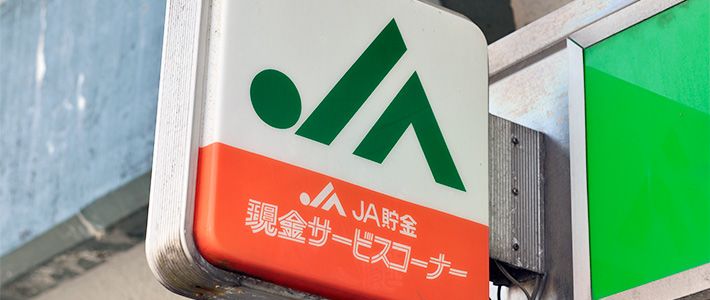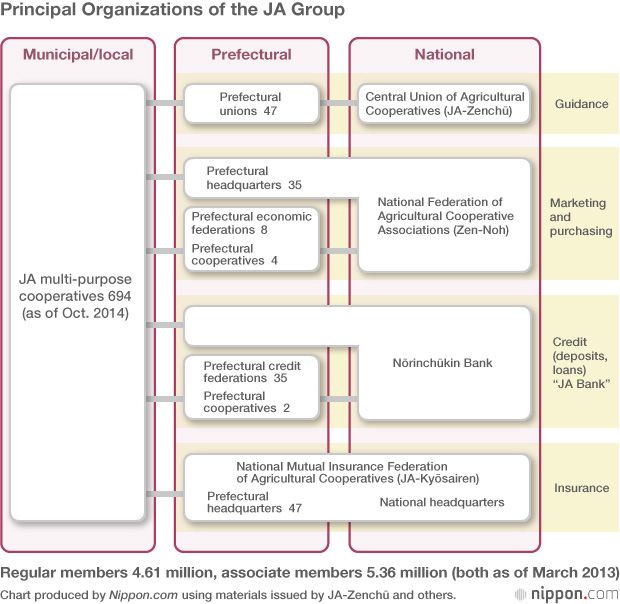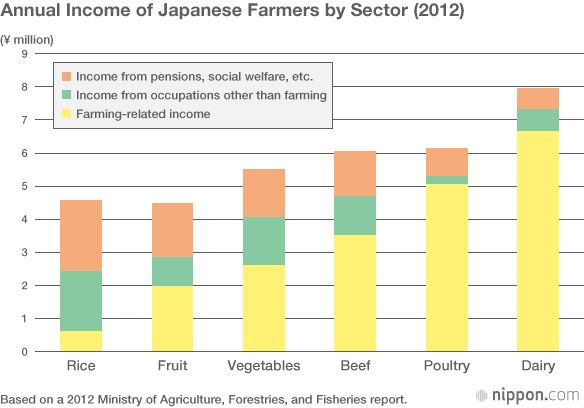
A First Step Toward Reform of Japan’s Agricultural Cooperative System
Politics Economy- English
- 日本語
- 简体字
- 繁體字
- Français
- Español
- العربية
- Русский
In 2014, reform of the Japan Agricultural Cooperatives (JA) group, the most influential body in postwar Japanese politics, finally made it onto the government’s agenda. This is presumably related to the efforts by the administration of Prime Minister Abe Shinzō to push through the Trans-Pacific Partnership. The political clout of the JA group currently presents the single biggest obstacle to reaching an agreement on the TPP free trade pact, and the government has decided it needs to clip the wings of this powerful farm lobby.
I will touch on the particulars of these reforms in the latter part of this article, but first I would like to explain the background to Japan’s distinctive system of agricultural cooperatives.
Roots of the Cooperatives
In order to allow the government to procure rice from farmers during the food shortages in the immediate aftermath of World War II, agricultural cooperatives were formed as successors to the regulatory organs that had been in charge of all aspects of farming and other activities in villages during the war years, including the collection of produce. To help them fulfill their role, they were granted the exceptional right to do banking business, taking deposits and making loans. Also, these associations of farmers were allowed to offer membership to nonfarmers as well: Any resident of the community could become an associate member of the local agricultural cooperative and make use of its services. Subsequently the JA group added life insurance and property insurance to its roster. Japan’s agricultural cooperatives emerged as the nation’s most multifaceted incorporated entities.
Ordinarily a cooperative is an independent body set up and run by its members. But the JA, with roots in the organs of the wartime command economy, emerged as an institution with a top-down power structure geared to transmitting instructions and orders from the central headquarters to the local organizations. The local agricultural cooperatives are under the control not of their members, as one would expect in principle, but of the Central Union of Agricultural Cooperatives (JA-Zenchū) in Tokyo and the 47 prefectural unions affiliated with it.
Another normal function of agricultural cooperatives is to enable farmers to purchase agricultural supplies cheaply. But in practice JA cooperatives use their exemption from antitrust laws to push fertilizers, pesticides, machinery, and animal fodder onto members at twice the price they are sold for in America. The need to use these expensive supplies pushes up farmers’ costs and the prices of their produce. And the inflated prices of both agricultural supplies and agricultural produce enable the JA to earn large amounts in sales commissions. The JA has created the high-cost structure of Japanese farming, and high tariffs on imported produce are necessary to maintain this structure in the face of lower prices on international markets.

JA to Blame for Agricultural Decline
Farmers’ incomes consist of sales (production volumes times prices) minus costs. Boosting sales and reducing costs are, therefore, two clear ways to increase income. Increasing the size of farms would allow farmers to reduce costs through economies of scale. But with the available farmland limited by Japan’s mountainous topography, increasing the size of farms means reducing the number of them. This is a politically unpopular policy option. The JA instead sought to maintain the existing number of rice-farming households and resisted structural reforms. From the 1960s onward, it conducted a large-scale political campaign to hike rice prices repeatedly as a means of boosting farmers’ incomes rather than making structural reforms.
From the war years until 1995, under a government policy of purchasing rice produced by domestic farmers, increases in the officially set prices enabled smallholder farmers who would ordinarily have been forced out of agriculture by high costs to continue their activities. As a result, these smallholder farmers held on to their enclosures, preventing full-time farmers who depend on agriculture for their livelihood from increasing the scale of their own operations by acquiring further land. The percentage of domestic rice sales accounted for by such full-time operations is correspondingly low—only 38%, in contrast to other agricultural sectors like dairy (95%) and vegetables and other arable produce (82%).
Japan’s rice production went into a decline, with inflated prices, the accumulation of part-time farmers, decreasing demand, and production surpluses eventually leading to the introduction of a policy aimed at reducing rice acreage nationwide. The inefficiency of rice production in Japan is illustrated by the fact that although 70% of the nation’s farmers grow rice, the crop accounts for only 20% of the country’s total agricultural production.
The chart below illustrates just how low a share of rice farmers’ income comes from farming and how much they rely on income from other sources, such as additional employment or pensions. In fact the vast majority of rice farmers are actually engaged full-time in other professions or are pensioners. Of all the farms producing rice, the share operated by full-time farmers amounts to a mere 10%.

In fact, the increasing share of part-time or aged rice producers has also strongly affected the development of the JA. Many of these farmers are actually eager to get out of farming and will gladly sell their farm plots for the right price to developers wishing to build houses, factories, or shopping centers on them. This is highly convenient for the business of the JA group agricultural cooperatives, which are also engaged in banking. Not only do members deposit their income from other occupations and pensions with the cooperatives’ banking system, JA Bank, but they also entrust it with the sums they receive from selling their land, which run into hundreds of millions of yen in additional deposits per year. As a result, the combined total of savings deposited with JA Bank as of the end of January 2015 had swollen to a staggering ¥94 trillion, leaving JA Bank vying with domestic banks Mizuho and Sumitomo Mitsui (with total deposits of ¥102 trillion and ¥85 trillion, respectively, both as of September 2014) for the title of Japan’s second-largest financial institution.
Agriculture in Japan is in decline, so only 1%–2% of JA Bank’s total deposits are used to finance farming. But, as noted above, nonfarmers are allowed to become associate members of the JA group’s cooperatives, and some 30% of the bank’s deposits go to supply housing loans and other types of loans to members. (As of the end of fiscal 2012, associate members outnumbered regular members by around 750,000.) The remaining funds are managed by Nōrinchūkin Bank, the central financial institution overseeing the JA Bank system; this is a colossal operation with investments the world over, including on Wall Street. The JA system has driven farming into decline, and now the JA itself is moving away from the sector. It has ceased to be an organization dedicated to agricultural finance farming.
If tariffs were eliminated and it became impossible to maintain high rice prices, the very foundations of JA’s existence would be jeopardized. This is why the organization has actively promoted demonstrations against the TPP multilateral free trade pact currently under negotiation. To the JA, high rice prices are an interest that it wants to protect at all costs, even to the overall detriment of Japanese agriculture.
Every country has groups that lobby the government on behalf of the farming sector, but Japan is the only country in which such a body is also involved in business and finance. And the institution’s political platform and financial interests are both tied to the maintenance of high rice prices. What the JA is concerned about protecting is not the financial welfare of the farmers who comprise its regular membership nor the health of Japanese agriculture as a whole, but rather its own interests.
Reforms under Abe
Against this backdrop, one product of Abenomics, the economic policies of the Abe administration that is so eager to push through Japan’s participation in TPP, is that the first overhaul of the agricultural cooperative system in around 60 years is finally underway. In May 2014, the government’s Regulatory Reform Council issued a report on agricultural reform that included the recommendations outlined below.
The first recommendation was to strike the provisions relating to both JA-Zenchū and the prefectural unions from the Agricultural Cooperatives Act. Compulsory membership fees collected by these unions from local JA farming cooperatives come to some ¥8 billion annually in the case of JA-Zenchū and over ¥30 billion for the prefectural unions. Without legally enshrined backing, the unions would be unable to collect such fees, operate as a political lobby, or exercise control over the cooperatives under their jurisdiction through compulsory auditing.
Secondly, the council called for National Federation of Agricultural Cooperative Associations (Zen-Noh), the Hokkaidō Federation of Agricultural Cooperatives (Hokuren), and other bodies responsible for the sale of agricultural produce and provision of agricultural materials to be stripped of their status as cooperatives and turned into ordinary corporations (stock companies). Although the JA group’s economic activities represent a colossal enterprise, with an 80% share of the fertilizer market and 60% of the markets for both pesticides and agricultural machinery, they are exempted from antitrust legislation because of the JA organizations’ cooperative status. Moreover, although ordinary corporations are required to pay corporation tax at a rate of 25.5%, the cooperatives pay only 19%. This, along with their exemption from real estate tax, is one of a number of tax breaks to which the farming cooperatives have long been entitled.
The third recommendation was to limit the utilization of cooperative services by associate JA members to less than half that by regular members—that is, farmers.
But subsequent talks between the administration and the ruling Liberal Democratic Party led to the announcement of an agreement the following month (June 2014) that effectively gutted the council’s recommendations. In a bow to the wishes of JA-supported LDP legislators, the agreement provided that the JA would have the final say regarding implementation of the proposed reforms.
Subsequently, in a set of self-reform proposals issued by JA-Zenchū the following November, the body sought to maintain its exclusive right to audit local JA cooperatives, and it argued for continued inclusion of provisions relating to itself and the prefectural unions in the Agricultural Cooperatives Act.
But Prime Minister Abe was determined to push through a more substantive overhaul of the cooperatives, and so the LDP’s senior members concerned with agricultural affairs undertook consultations with JA-Zenchū President Banzai Akira, reaching the following compromise in February 2015: (1) The provisions relating to JA-Zenchū are to be struck from the Agricultural Cooperatives Act, and the organization will become a general incorporated association like Keidanren (Japan Business Federation). (2) Local JA cooperatives will be able to choose to be audited either by an auditing firm split off from JA-Zenchū or by other auditing firms. (3) The provisions relating to the cooperative status of the prefectural unions will remain on the statute books. (4) The decision on whether or not to turn Zen-Noh into a regular corporation will be left up to Zen-Noh itself. (5) The idea of limiting the services provided for associate members is to be deferred. The government will prepare a revision of the Agricultural Cooperatives Act in line with this agreement and submit it to the National Diet in March or later this year.
Making submission to JA-Zenchū auditing voluntary will reduce the level of control the body is able to exercise over local JA cooperatives, which will enjoy a greater degree of autonomy as a result. But the JA’s political influence looks set to remain undiminished. Even if JA-Zenchū becomes a general incorporated association at the national level, the prefectural unions will retain their current status, and so they will be able to continue to collect compulsory membership fees from local JA cooperatives. All of the prefectural unions are also members of JA-Zenchū, so income from the fees they collect will continue to flow to that body. And since the benefits of retaining cooperative status are substantial, so it is highly unlikely that organizations like Zen-Nōh will opt to become ordinary corporations.
The Regulation Reform Council’s proposal to limit the JA’s associate membership rolls was likely a feint or other strategic move on the part of the government. Fewer associate members would mean a shortage of prospective borrowers for the JA’s banking arm. Faced with this prospect, the local cooperatives and the prefectural unions probably judged that they could much more readily accept the loss of JA-Zenchū’s exclusive right to audit local cooperatives than lose associate members, and so it decided to yield on the auditing issue and other points on the condition that it be allowed to keep these members.
Yet there is something rather abnormal about an “agricultural” cooperative with such a large portion of its membership comprised of nonfarmers. The current local JA cooperatives should close down their agricultural departments and turn themselves into local cooperative associations focusing on banking and insurance services and the provision of everyday goods. If there is a need for agricultural cooperatives, full-time farmers can set them up on their own initiative. These would be true cooperatives.
Additionally, under the present system, in which votes from both full-time and part-time farmers carry equal weight, JA decision making is predominantly driven not by the opinions of those who rely on agriculture for their livelihood but by those whose actual engagement in farming is minimal. As yet, no suggestions have been made regarding fundamental moves like reform of this voting system or a switch from the current JA group cooperatives to local cooperatives. The overhaul of the current JA setup cannot be allowed to end here.
Even so, the recently agreed reforms are far from meaningless. The Ministry of Agriculture, Forestry, and Fisheries, the JA, and legislators of the agricultural “tribe” in the Diet have decided all agricultural policies by themselves. Take the TPP, for example. They made the Diet agricultural committees adopt resolutions urging the government to have Japan’s rice, wheat, beef and pork, dairy products, and sugar exempted from tariff elimination under the TPP agreement and to leave the negotiating table if unable to do so. These resolutions constrain and restrict the government’s TPP negotiations. Previously, the tussles among them, if any, took place behind closed doors. But the JA now seems to be pitted in an all-out confrontation with MAFF, which it has sharply criticized for “betraying” it on the reform issue. Cracks have appeared in the strong and solid ties binding MAFF, the JA, and the legislators. The reform package may not have quite lived up to expectations, but it is highly significant that it has caused these cracks to emerge. This may affect any agricultural policy reforms in the future to a great extent.
(Originally written in Japanese and published on March 11, 2015. Banner photo: A sign outside one of JA’s many regional branches. © Jiji Press.)